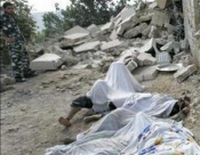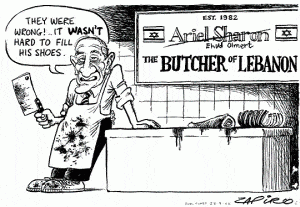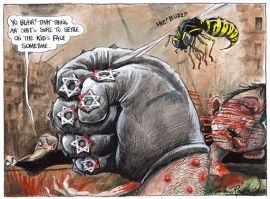The media’s coverage of Israel’s conflict with the Iranian-backed Hezbollah terrorist group was filled with examples of bias, inaccuracy, and manipulation. While firing thousands of rockets into Israeli cities, Hezbollah was able to frequently manipulate the media into portraying the conflict as a “disproportionate” Israeli attack against Lebanese civilians. In news stories, photographs, and political cartoons, we have seen some of the worst reporting in years. While the cease-fire is very tenuous right now, we thought it would be useful to review some of the worst cases of media bias so that readers will know what to look for should the fighting resume.
Hezbollah Manipulation of Journalists
Typical of Hezbollah’s manipulation of the media was the live story Nic Robertson submitted from Lebanon. Robertson was given a tour by “Hezbollah Press Officer” Hussein Nabulsi.
Click here to see the CNN report, courtesy of Newsbusters.org. Throughout the interview, Robertson simply accepts Nabulsi’s claims that Israel was only attacking civilian areas. “No evidence of military equipment here,” Robertson tells CNN’s global audience. At several points, Nabulsi actually tells Robertson’s cameraman exactly what to film.
A week after the report aired, Robertson appeared on CNN’s “Reliable Sources” where he admitted that he had no way of confirming what he had just told the world. In Robertson’s own words:
“(Hezbollah) had control of the situation. They designated the places that we went to, and we certainly didn’t have time to go into the houses or lift up the rubble to see what was underneath. (Hezbollah) has very, very good control over its areas in the south of Beirut. They deny journalists access into those areas. You don’t get in there without their permission. We didn’t have enough time to see if perhaps there was somebody there who was, you know, a taxi driver by day, and a Hezbollah fighter by night.”
Compare the total acceptance of Hezbollah claims with the dismissal of Israeli explanations witnessed here in this CNN interview with the chief spokeswoman for the Israeli Defense Forces.
“Disproportionate” Reporting
Throughout the conflict, there were numerous reports of the damage in Lebanon. While it is true that the conflict extracted a great toll on Lebanese infrastructure, there was also considerable damage to Northern Israel. Consider these rarely reported statistics (from the Israeli Ministry of Foreign Affairs):
-
43 Israeli civilians were killed by Hezbollah rocket fire
-
116 Israeli soldiers and officers were killed
-
3,970 rockets were fired at Israel, 901 of them hit urban areas
- 4,262 civilians were treated in hospitals for injuries
-
6,000 Israeli private homes were damaged
-
300,000 Israelis were forced to flee
-
Over 1,000,000 Israelis were forced to spend a month in bomb shelters
-
One third of the population of Israel was directly exposed to the missile threat
-
Over $1,400,000,000 is estimated to be the direct economic loss to the Israeli economy.
On the other hand, many in the media have been going overboard on reporting “devastation” in Lebanon. Check out the HonestReporting UK website to see how the BBC’s Orla Guerin was caught attempting to exaggerate the level of damage in a Lebanese village.
Inflated Accounts of Lebanese Casualties
 Several times the media repeated casualty figures without trying to confirm their accuracy.
Several times the media repeated casualty figures without trying to confirm their accuracy.
There are even those who suggest that some of the pictures of Lebanese casualties were staged. In the AFP picture to the left of what was purported to be dozens of dead following an IDF bombing, either a body is “sitting up” or the body is frozen in place by rigor mortis, indicating that the person died at least 24 hours beforehand.
Many in the media were embarrassed following the admission by Lebanese President Siniora that only one person had died in an Israeli air strike on the town of Houla, not 40 which he had originally claimed and which was repeated in countless media stories.
Typical of the original reporting was this AFP story which simply accepted Siniora’s accusation at face value:
40 dead in Israeli raid on village — Lebanese PM
Agence France-Presse
Last updated 08:10pm (Mla time) 08/07/2006
BEIRUT – (UPDATE) Lebanese Prime Minister Fuad Siniora on Monday said Israeli raids had killed more than 40 people in a “deliberate massacre” in the southern village of Hula as he urged Arab foreign ministers to support an immediate and unconditional ceasefire.
“One hour ago there was a horrible massacre in the village of Hula, a deliberate massacre, in which there were more than 40 martyrs,” Siniora told the ministers at their crisis meeting in Beirut.
Later, even Siniora admitted that only one person had died. While the media was quick to retract the earlier statement, the damage had already been done. This incident came on the heels of the strike against Qana where it was originally reported that 56 people had been killed. Later, it was determined that the correct number was 28. The original number had been given to the media by the Lebanese Red Cross and had included those who were missing and others that had been at the destroyed building at one time.
Manipulated and Staged Photographs

When the blog Little Green Footballs first reported that a Reuters photograph had clear signs of manipulation (see the duplication of smoke patters and cloning of destroyed buildings), it was a call to the media to take a closer look at all photographs coming out of Lebanon. Since then, numerous photographs have been discovered to have been purposely manipulated or deliberately staged.
For example, numerous photos appeared in the media of an apparent victim of Israeli bombing. However, this same “victim” is sometimes seen alive and posing for the cameras and sometimes pretending to be dead. The New York Times, which had originally captioned the photo as a “victim of Israeli bombing” was forced to issue this correction:
“A picture caption with an audio slide show on July 27 about an Israeli attack on a building in Tyre, Lebanon, imprecisely described the situation in the picture. The man pictured, who had been seen in previous images appearing to assist with the rescue effort, was injured during that rescue effort, not during the initial attack, and was not killed.”
In one example, cameras film a body being loaded into an ambulance. Apparently, the “handlers” at the scene did not think that the footage had been good enough (“better images must be shot”), so they now took the body back out of the ambulance and posed it for the cameras a few times.
For more on photo bias, see these articles from the blog ZombieTime and the Israeli website of the newspaper Yediot which summarize the major frauds that have been uncovered. Also, take the HonestReporting Smoke and Mirrors Quiz to test your knowledge.
Intimidation of Journalists
Perhaps one reason for the biased reporting against Israel was Hezbollah’s intimidation of journalists. Time magazine contributor Christopher Allbritton, wrote in his blog: “To the south, along the curve of the coast, Hezbollah is launching Katyushas, but I’m loathe to say too much about them. The Party of God has a copy of every journalist’s passport, and they’ve already hassled a number of us and threatened one.” Richard Engel from NBC news was even more clear. In discussing his reporting from Lebanon, his Hezbollah “handlers” said: “Look, we’re serious, we will kill you if you film these outgoing rockets.”
Anti-Semitic Cartoons
 The conflict also produced some of the most vile anti-Semitic political cartoons we have seen in years. While these types of horrifying images are typical in the Arab world, the following cartoons appeared in the Western media. The first cartoon is by Jonathon Shapiro (“Zapiro”)and appeared in South Africa’s Sunday Times. Israeli Prime Minister Olmert is saying “They were wrong, it wasn’t hard to fill his shoes.”
The conflict also produced some of the most vile anti-Semitic political cartoons we have seen in years. While these types of horrifying images are typical in the Arab world, the following cartoons appeared in the Western media. The first cartoon is by Jonathon Shapiro (“Zapiro”)and appeared in South Africa’s Sunday Times. Israeli Prime Minister Olmert is saying “They were wrong, it wasn’t hard to fill his shoes.”

The second cartoon was drawn by Martin Rowson for the British Guardian. It shows a bloody glove with embedded Stars of David. The fist is crushing a Lebanese child. The caption reads, “Yo Blair, that thing ain sh** sure to settle on the kids’ face sometime.”
These are just a few of the media offenses we witnessed during the conflict. The cease-fire is very weak in that it appears that the requirement that Hezbollah be disarmed is being ignored by both the Lebanese government and the United Nations. On the other hand, Israel has already been accused of violating the agreement by sending a commando raid to try and stop Hezbollah from rearming. Keep the media honest and remind them that according to the cease-fire resolution, (look at the third operative clause) no outside groups may send weapons to Hezbollah.
Due to the incredible volume of coverage, not all instances of media bias can be specifically highlighted by HonestReporting. We call on our subscribers to go the extra mile and respond to the media where necessary. We regret that we are not always able to respond to the number of e-mail requests we have been receiving. Click here to find contact details for major international outlets.

